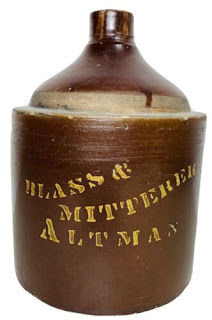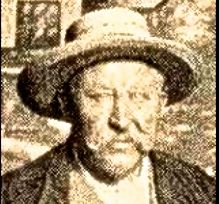E. A. Mitterer Ran Boomtown Saloons in Violent Times
 The whiskey jug shown here unfolds the story of Emanuel A. Mitterer, who as a youth who left his Austrian homeland for the gold lands of Colorado. Amid the wild scramble for wealth and labor tumult of the times, Mitterer successfully ran saloons catering to miners, got married, and fathered four children. Emerging unscathed by the violence all around, he later moved to Denver and lived to “a ripe old age.”
The whiskey jug shown here unfolds the story of Emanuel A. Mitterer, who as a youth who left his Austrian homeland for the gold lands of Colorado. Amid the wild scramble for wealth and labor tumult of the times, Mitterer successfully ran saloons catering to miners, got married, and fathered four children. Emerging unscathed by the violence all around, he later moved to Denver and lived to “a ripe old age.”
Mitterer was born in December 1873 in the Tyrol region of the Austrian Alps, in a bucolic village in the shadow of snow-covered mountains. Arriving in America sometime between 1887 and 1889 (records differ), he found his way to a gold strike boomtown in the Colorado Rockies call Altman. It was one of the highest communities in America at 11,000 feet. Despite the mountain backdrop it bore no resemblance to Mitterer’s homeland. Shown below as it looked in 1897, Altman was a ramshackle settlement, houses and commercial buildings thrown together of rough timbers.
Founded in 1893, with a peak population of 1,200, Altman was the product of the gold strikes in the Cripple Creek District. Gold mining had begun in the 1890s, mostly as underground operations, chasing high grade veins. Area gold mining has continued to this day. Over 23 million ounces of gold have been recovered from the district since 1890 said to be worth more than $40 billion dollars.
 Mitterer was an entrepreneur, not a miner. He recognized, however, the wealth being generated and the propensity of the miners, most of them without wives present, to spend their off-hours in drinking establishments. With a partner named Blass, Mitterer open one of the nine saloons in Altman. His drinking establishment likely resembled the false-front Altman enterprises shown above. The interior similarly would have been without frills, warmed by a potbellied stove in the frigid temperature of the harsh Colorado winter.
Mitterer was an entrepreneur, not a miner. He recognized, however, the wealth being generated and the propensity of the miners, most of them without wives present, to spend their off-hours in drinking establishments. With a partner named Blass, Mitterer open one of the nine saloons in Altman. His drinking establishment likely resembled the false-front Altman enterprises shown above. The interior similarly would have been without frills, warmed by a potbellied stove in the frigid temperature of the harsh Colorado winter.
 There Mitterer and his partner appeared to have been buying whiskey by the barrel, mixing up their own brand of whiskey and selling at both retail and wholesale. For this purpose they used large ceramic jugs with their names and Altman stenciled in a brown slip that covered most of the container but left a bit of the underly pottery bare. These jugs have been termed “one of the very rarest of the Old West.” The ceramic opening this post recently sold at auction for $1,600, one of two similar containers known. A third jug, shown here, is claimed as a singularity because the letters are slightly raised.
There Mitterer and his partner appeared to have been buying whiskey by the barrel, mixing up their own brand of whiskey and selling at both retail and wholesale. For this purpose they used large ceramic jugs with their names and Altman stenciled in a brown slip that covered most of the container but left a bit of the underly pottery bare. These jugs have been termed “one of the very rarest of the Old West.” The ceramic opening this post recently sold at auction for $1,600, one of two similar containers known. A third jug, shown here, is claimed as a singularity because the letters are slightly raised.
While Mitterer tended bar, trouble was brewing in prosperous Altman. The miners were making $4.00 a day for an eight hour day in the mines — a hefty paycheck in those days. The wages attracted many jobseekers to the site. Early in 1894 some mine owners took advantage of the labor surplus to mandate that the work day would be increased from eight to nine or ten hours, with no pay increase. Miners were given the option of keeping the eight-hour work day with a pay decrease of fifty cents a day.
The potential pay cut brought early violence to the Cripple Creek District and particularly to Altman, headquarters of the Western Federation of Miners (WFM), a labor union not averse to using dynamite to get its way. Some mines shut down and others were hit with explosions. Violent incidents in and around Altman multiplied as armed strikebreakers hired by the mine owners made their camp above the town. The miners rigged up a catapult that could hurl dynamite into the camp. The strikebreakers skedaddled. Colorado’s governor called in the state militia to replace them, the encampment shown below.
 Miners in Altman responded to the threat by barricading Altman and announcing they had seceded from the state. Shown here is a detail of a fund-raising flyer developed by the WFM. It outlines the grievances claimed by the union. In the end the mine owners were forced to capitulate completely as their lost revenues from gold mounted. The miners went back to work, usual hours, usual pay.
Miners in Altman responded to the threat by barricading Altman and announcing they had seceded from the state. Shown here is a detail of a fund-raising flyer developed by the WFM. It outlines the grievances claimed by the union. In the end the mine owners were forced to capitulate completely as their lost revenues from gold mounted. The miners went back to work, usual hours, usual pay.
Trouble continued to plague Altman. Facing declining residencies In 1903, the female proprietor of the Altman Hotel, Mrs. Ollie Davisson, with co-conspirators, contrived a plan to torch the hostelry for the insurance money. Enlisting a former employee of the Altman Water Company in their scheme, they shut off the town water supply and started a fire in the hotel. According to one newspaper account: “Being on a windy hilltop, the blaze quickly got out of control and no water was available to fight it. The fire burned the entire business district and most of the homes in the town. Losses were estimated to be $75,000 while insurance would only cover $10,000 of the losses.” The fire sounded the death knell for Altman.
In the meantime Mitterer had made a life there. In April 1897 in Denver he married Amalia F. Staiger, an immigrant from Germany who was eight years his junior and brought her back to Altman to live. Their first son, Albert, would be born there. My assumption is that the family may have lived over the saloon, a common practice. Whether it was the violence or a premonition of Altman’s decline, Mitterer moved to another district mining town, aptly named “Goldfield.”
Shown above as it looked in the early 1900s, Goldfield was a more settled community than Altman, one with churches, schools and solidly built homes, although its economic engine also was the lucrative gold mines. Goldfield was the third largest community in the Cripple Creek District with about 3,500 citizens at its peak in 1900. The town was built around the Portland mine, one of the best gold-producers in the district. Although miner unrest had occurred there, Goldfield had avoided major conflict.

 Mitterer opened his new drinking establishment at 908 Portland Street, calling it the “Portland Saloon.” No liquor jugs are known from this saloon but the proprietor was notable for issuing bar tokens that have survived, all considered very rare. One token was made of aluminum, a costly metal in that day, and a second, in brass or bronze. Both carry the same message. The front bears Mitterer’s name, and Goldfield, Colo. The back designates its value at five cents. In boomtown Goldfield that may have been enough to buy a beer, but likely not a shot of bar whiskey.
Mitterer opened his new drinking establishment at 908 Portland Street, calling it the “Portland Saloon.” No liquor jugs are known from this saloon but the proprietor was notable for issuing bar tokens that have survived, all considered very rare. One token was made of aluminum, a costly metal in that day, and a second, in brass or bronze. Both carry the same message. The front bears Mitterer’s name, and Goldfield, Colo. The back designates its value at five cents. In boomtown Goldfield that may have been enough to buy a beer, but likely not a shot of bar whiskey.
 A Cripple Creek directory indicates that the Mitterer family was growing. Son John was born in Goldfield in August, 1899, followed by twins Olga and Adolph in January 1901. The 1910 Census found Emanuel, Amelia and the four children there. Mitterer’s occupation was given as “retail liquors and saloon.” In May of that year, Amalia died, She was buried in Sunnyside Cemetery in nearby Victor, Colorado. Her monument is shown here.
A Cripple Creek directory indicates that the Mitterer family was growing. Son John was born in Goldfield in August, 1899, followed by twins Olga and Adolph in January 1901. The 1910 Census found Emanuel, Amelia and the four children there. Mitterer’s occupation was given as “retail liquors and saloon.” In May of that year, Amalia died, She was buried in Sunnyside Cemetery in nearby Victor, Colorado. Her monument is shown here.
Left with four children to raise, ages from 9 to 12, Emanuel married again within six months. His new wife was Marie B. Gruenler, a 42-year old woman whose home was Denver. Although she joined him in Goldfield, Mitterer subsequently sold his saloon and moved to Denver. There he abandoned the liquor trade in favor of working as a cabinetmaker. By 1932, he had risen to treasurer of the South Denver Planing Mills Company.
 Successfully having avoided becoming a casualty of what came to be known as the Colorado Labor Wars, Mitterer lived to be 88 years old, dying in 1951. He was buried in Mount Olivet Cemetery, Wheat Ridge, Colorado. His gravestone is shown here. Strangely, neither of his wives is buried with him, only a daughter-in-law.
Successfully having avoided becoming a casualty of what came to be known as the Colorado Labor Wars, Mitterer lived to be 88 years old, dying in 1951. He was buried in Mount Olivet Cemetery, Wheat Ridge, Colorado. His gravestone is shown here. Strangely, neither of his wives is buried with him, only a daughter-in-law.
Notes: This post was garnered from a range of sources, including Colorado newspaper stories and Internet historical and genealogical sites. The photos of tokens are from i-collector.com.








Comments
Post a Comment